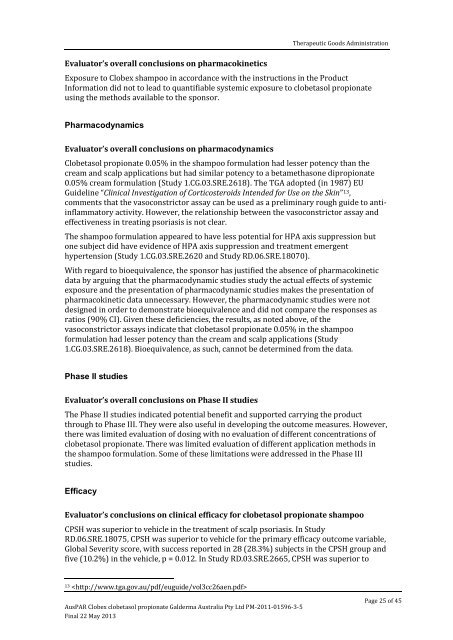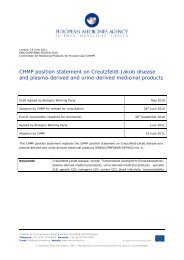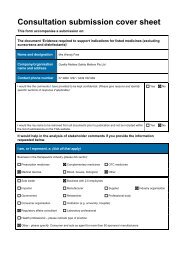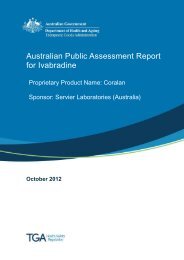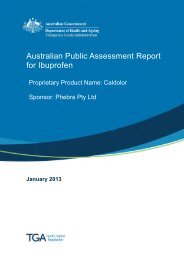AusPAR: Clobetasol propionate - Therapeutic Goods Administration
AusPAR: Clobetasol propionate - Therapeutic Goods Administration
AusPAR: Clobetasol propionate - Therapeutic Goods Administration
You also want an ePaper? Increase the reach of your titles
YUMPU automatically turns print PDFs into web optimized ePapers that Google loves.
<strong>Therapeutic</strong> <strong>Goods</strong> <strong>Administration</strong>Evaluator’s overall conclusions on pharmacokineticsExposure to Clobex shampoo in accordance with the instructions in the ProductInformation did not to lead to quantifiable systemic exposure to clobetasol <strong>propionate</strong>using the methods available to the sponsor.PharmacodynamicsEvaluator’s overall conclusions on pharmacodynamics<strong>Clobetasol</strong> <strong>propionate</strong> 0.05% in the shampoo formulation had lesser potency than thecream and scalp applications but had similar potency to a betamethasone di<strong>propionate</strong>0.05% cream formulation (Study 1.CG.03.SRE.2618). The TGA adopted (in 1987) EUGuideline “Clinical Investigation of Corticosteroids Intended for Use on the Skin” 13 ,comments that the vasoconstrictor assay can be used as a preliminary rough guide to antiinflammatoryactivity. However, the relationship between the vasoconstrictor assay andeffectiveness in treating psoriasis is not clear.The shampoo formulation appeared to have less potential for HPA axis suppression butone subject did have evidence of HPA axis suppression and treatment emergenthypertension (Study 1.CG.03.SRE.2620 and Study RD.06.SRE.18070).With regard to bioequivalence, the sponsor has justified the absence of pharmacokineticdata by arguing that the pharmacodynamic studies study the actual effects of systemicexposure and the presentation of pharmacodynamic studies makes the presentation ofpharmacokinetic data unnecessary. However, the pharmacodynamic studies were notdesigned in order to demonstrate bioequivalence and did not compare the responses asratios (90% CI). Given these deficiencies, the results, as noted above, of thevasoconstrictor assays indicate that clobetasol <strong>propionate</strong> 0.05% in the shampooformulation had lesser potency than the cream and scalp applications (Study1.CG.03.SRE.2618). Bioequivalence, as such, cannot be determined from the data.Phase II studiesEvaluator’s overall conclusions on Phase II studiesThe Phase II studies indicated potential benefit and supported carrying the productthrough to Phase III. They were also useful in developing the outcome measures. However,there was limited evaluation of dosing with no evaluation of different concentrations ofclobetasol <strong>propionate</strong>. There was limited evaluation of different application methods inthe shampoo formulation. Some of these limitations were addressed in the Phase IIIstudies.EfficacyEvaluator’s conclusions on clinical efficacy for clobetasol <strong>propionate</strong> shampooCPSH was superior to vehicle in the treatment of scalp psoriasis. In StudyRD.06.SRE.18075, CPSH was superior to vehicle for the primary efficacy outcome variable,Global Severity score, with success reported in 28 (28.3%) subjects in the CPSH group andfive (10.2%) in the vehicle, p = 0.012. In Study RD.03.SRE.2665, CPSH was superior to13 <strong>AusPAR</strong> Clobex clobetasol <strong>propionate</strong> Galderma Australia Pty Ltd PM-2011-01596-3-5Final 22 May 2013Page 25 of 45


